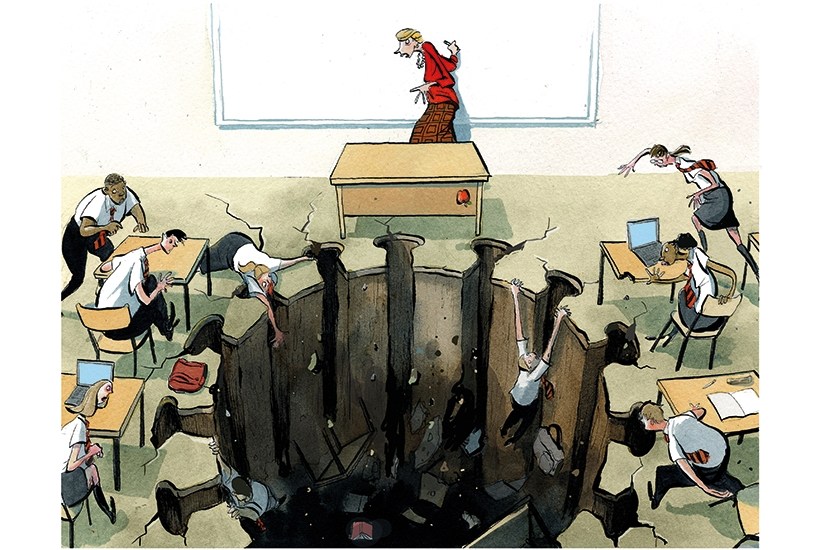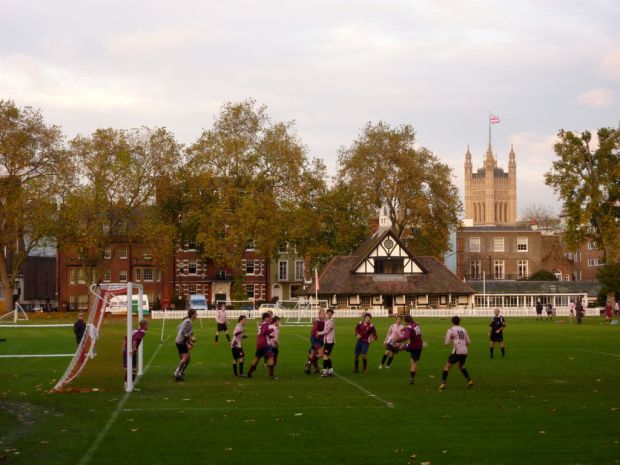It’s Monday at 9 a.m. and secondary schools in England have just re-opened their gates to students in Years 10 and 12. I have been looking forward to this moment for 13 long weeks, since that frightening afternoon in March when my colleagues and I gathered around a computer in the staff room and saw a healthier-looking Boris Johnson declare he was shutting schools.
But today I’m not at the comprehensive in Hackney where I teach economics welcoming back my students with a rousing lesson on the financial devastation caused by the crisis. I’m surplus to requirements and am still marooned at home. What ‘re-opening’ means is that a mere quarter of Year 10 — about 40 students — have turned up to school, where they will have a short day and learn mainly maths, English and science.
My school, like every other in the land, has followed government orders and done a gold-plated risk assessment to ensure these students will be safe. It has laid out rules covering the movement of every teenager for every second of the truncated school day. With barely 40 of them in at any given time, occupying a space built for 750, the risk of anyone picking up the virus must be smaller than the risk of falling downstairs and cracking their heads on the tiled floor below. It must be far lower than the risk of acquiring Covid-19 at Tesco or Primark; and in a different league of magnitude to the risk of having picked it up last weekend on nearby London Fields, where the crowds of picnickers, revellers and drinkers reminded me of Glastonbury.
While the health danger to these few students of returning to school is minuscule, the risk to the others of staying at home in their bedrooms, where they have been incarcerated for three months on Google Classroom or similar, is monumental.
Today, instead of being able to do the part of my job I love, being in a real classroom with real children, I am sitting at home staring at some slides I’ve just made and talking to my computer. ‘Stop the video now’ — I’m saying — ‘and write down the definition of fiscal policy.’
I’m trying to make my voice sound light but my heart is heavy. There are 25 students in this particular class. Eight of them will listen carefully and follow my instructions to a T. A further eight will do the work more sloppily. The rest will not do it at all.
There has been much talk about how the closure of schools has widened the gap in educational achievement. The eight students who will watch my video and pause every time I say pause are the same eight I had no worries about before the virus struck. Some are middle-class children and most are girls, but all have a rock-solid work ethic and are well supported by their parents. The students doing nothing are the same students I was fretting about from the moment I started teaching them. Many are poor. Some have behavioural difficulties. Some have complicated special needs. For most, it is a Herculean job to get them to work at the best of times — even with the strict structure provided by the school. None of them has done a single sausage since this nightmare began.
Every week of lockdown, all teachers at my school fill in a spreadsheet to track how the students are doing. A drop-down menu gives the option ‘behind with work’ — but this doesn’t quite cover it. It is not just that these ones are behind with new content, but by September they will have forgotten all the old stuff and, more importantly, lost work habits that the school has been painstakingly instilling since their first day in Year 7.
According to the Education Endowment Foundation, the damage inflicted on educational equality by closing schools has undone the work not of a term but of a decade. Not only is the gap yawning between students in my class — it is widening between north and south, rich and poor, and between state and private schools. Research by UCL Institute of Education shows that in the south-east, 28 per cent of kids are working for more than four hours a day, compared with less than 10 per cent in the north-east. The children on free school meals are half as likely as richer ones to be working hard. And a third of private schools are offering four or more hours of lessons a day, five times as many as state schools.
‘Laptops!’ people have been crying. ‘The poorest kids don’t have laptops or internet connections!’ This is true, and the government and some schools have been trying to redress this, but online teaching is not a perfect solution. Even my students with laptops are losing the will to live as this situation goes on — and I can’t blame them. In teenage bedrooms all over the country parents may think their kids are doing their economics work on income inequality. But they’re not. They’re on Fortnite.
The damage done to students’ mental health is less well chronicled, but no less serious. I phone a teenage boy to find out why he has done no work. It’s 3 p.m. and he’s still in bed. His once-upon-a-time cheery voice is flat and he talks slowly in monosyllables. Adolescence is rubbish at the best of times. Try it in a tiny, impoverished flat with no outdoor space, nowhere to go, no one to see and nothing to do, with the guilt of the god-awful slides on Google Classroom hanging over you. All of my teacher acquaintances report conversations like this, or worse.
In longing for schools to go back, I’m at odds with some teaching unions and some teachers. I don’t blame them for their reticence — the fear of infection is something we all experience differently, and I’m at one extreme of the spectrum. All along I’ve wanted schools to open earlier — not because I’m a lockdown sceptic who puts the economy above lives, but because I am daily aware of the damage being done to some students, to their education, mental health and chances of a decent life.
Throughout, Downing Street has done a rotten job in balancing these risks. Its communication has been so patently diabolical that there’s no point in going over it again here. What has attracted less notice is its message about the purpose of schooling. In giving priority to the students who are soonest to sit GCSEs and A-levels, it is implicitly saying that exams are the point of education. This is both depressing and wrong. Exams are not the point of education: they are evidence that you’ve acquired some. The students who return this week will be learning how to answer a nine-mark exam question rather than being taught anything of interest. The coronavirus should have been an opportunity for people in education to think about what matters; we’ve missed that chance.
While government has had a rotten crisis, teachers have had a good one, whatever the critics might claim. Overnight, with no warning and no training, the entire profession shifted from whiteboard to wireless. In my old life as a journalist at the Financial Times, it took me five years to get used to the move from print to digital, and despite a good deal of training I still bitched and moaned. When I became a teacher three years ago, I was a dinosaur and technophobe, but even I have (just about) mastered Google Classroom, Zoom, Loom and the particularly dastardly Google Forms with little training and not much complaining.
We have all proved it’s possible to offer some sort of education online. Some schools are doing this brilliantly, but even the ones who have dragooned pupils into sitting through five hours of Zoom a day can’t touch the real thing. There is an irreplaceable magic in a live lesson, with its ability to motivate, cheer and inspire. A friend who is a documentary-maker-turned-teacher is hatching a plan to carry 100 desks into a park, place them two metres apart and teach Macbeth through a megaphone. I hope she pulls it off.
The National Education Union, the biggest teachers’ union, last week put out a plan for closing the gap. It has lots of good ideas in it, including opening libraries and theatres and other spaces for students to learn in. But there was a phrase that filled me with dread — ‘blended learning’. By September we may be teaching small classes in school and doing online teaching simultaneously. I do hope it doesn’t come to this, I really do.
There is only one shred of comfort. Four years ago, when I set up Now Teach, a charity to persuade older people to retrain as teachers, I did not think it would take a pandemic to do my PR work for me. Possibly it’s the experience of home-schooling children, or possibly it’s the way many other careers now seem precarious or pointless — either way, professionals are now queuing around the block to become teachers. At each of our recent information evenings (packed-out Zoom meetings), I’ve told teaching hopefuls what lockdown has taught me. It is not just that education matters more than anything — I knew that already — but that old–fashioned schooling is the best way of delivering it. In the past few months we’ve seen what happens to students, especially vulnerable ones, when you take away the physical presence of teachers, routine, social interaction, detentions and school dinners.
And as for me, I’m not poor or disadvantaged, I don’t have special needs, I do have a functioning laptop and internet connection, and I’m not 15. But I desperately want my school life back, too.
Got something to add? Join the discussion and comment below.
Get 10 issues for just $10
Subscribe to The Spectator Australia today for the next 10 magazine issues, plus full online access, for just $10.
spectator.co.uk/podcast - Lucy Kellaway and the IFS’s Paul Johnson on the growing educational gap.
You might disagree with half of it, but you’ll enjoy reading all of it. Try your first month for free, then just $2 a week for the remainder of your first year.














Comments
Don't miss out
Join the conversation with other Spectator Australia readers. Subscribe to leave a comment.
SUBSCRIBEAlready a subscriber? Log in